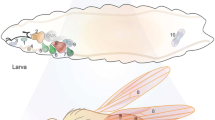Abstract
THE work of Bounoure1 and Blackler2 on three anuran species has shown that, in fixed and sectioned material, and after the application of suitable stains, the embryonic sites that contain primordial germ-cells may be recognized at all developmental stages from the fertilized egg to the tadpole. A technique for the transfer of the gonocytes between one embryo and another has been devised as a first step in a genetical analysis of abnormal embryos produced in this department by the transplantation of somatic nuclei into unfertilized eggs of Xenopus.
Similar content being viewed by others
References
Bounoure, L., Ann. Sci. Nat., 10e Ser., 17, 67 (1934).
Blackler, A. W., J. Embryol. Exp. Morph., 6, 491 (1958).
Nieuwkoop, P. D., and Faber, J., “Normal Table of Xenopus laevis” (North-Holland Pub. Co., 1956).
Elsdale, T. R., Fischberg, M., and Smith, S., Exp. Cell. Res., 14, 642 (1958).
Mintz, B., and Russell, E. S., J. Exp. Zool., 134, 207 (1957).
Author information
Authors and Affiliations
Rights and permissions
About this article
Cite this article
BLACKLER, A. Transfer of Germ-Cells in Xenopus laevis . Nature 185, 859–860 (1960). https://doi.org/10.1038/185859a0
Issue Date:
DOI: https://doi.org/10.1038/185859a0
- Springer Nature Limited





